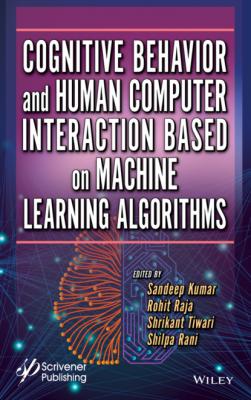Cognitive Behavior and Human Computer Interaction Based on Machine Learning Algorithms. Группа авторов
Чтение книги онлайн.
Читать онлайн книгу Cognitive Behavior and Human Computer Interaction Based on Machine Learning Algorithms - Группа авторов страница 11
 is subjected to their feedback; and
is subjected to their feedback; and4 Fuzziness of the delayed behavioral reactions among the groups to assess or predict.
An organized framework is described here as a generalization of any organized approach, providing inference process and cohesive interactions in the detailed guidelines related to any aspect of group interaction model building. This analysis aims to obtain a broad view of a global vision of investigating the research that applied group interaction modeling systems. Using system dynamics allows drawing keenness to the lack of advanced interactive device management aspects to support the relating behavior aspects.
The group modeling system approach’s dynamic behavior is characterized below, emphasizing group interaction model systems.
The modeling process using two types of information systems [7]:
1 Modeling information systems versus group interaction model information systems.
2 Expert modeling systems versus team expert modeling information systems.
1.1.4 Human-Computer User Interface Management Systems
Human-Computer User Interface (HCUI) design mainly emphasizes foreseeing what computer interaction users need to do and approve that the human-computer interface has several elements that are flexible and easy to know, view, navigate, update, manage and modify, and use to provide facilitation in the form of events and widgets. HCUI accomplishes the related features from interpreting, layout design, interaction design, visual design, and information architecture.
A HCUIMS (HCUI Management System) is treated as not as a system but rather an interactive software architecture (an HCUIMS is also called a HCUI Architecture) “in which the design, deployment of various applications’ user interface is precise and clearly distinguished from that of other applications’ underlying its functionality.” Such an eminent division’s cohesive objective is to enhance the maintenance ease and adaptability with other softwares. Most of the Modern HCUIMS Architectures are designed with integrated development environments. With the help of abstraction of a user interface from the applications logic, syntax, and semantics, the code generation is better supported for customization. Even these architectures have been proven and useful with a high degree of interaction and had semantic feedback at manipulating interfacing boundaries between applications and HCUIs are difficult or impossible to maintain [8].
1.1.5 Different Types of Human-Computer User Interfaces
1 Interface for Command Line
2 Interface for Menu Driven
3 Interface for Touch-Screen Driven
4 Interface for Graphical User Purpose
5 Interface for Event-Driven Purpose
6 Interface for Sensor-Based Users
7 Interface for Voice-Based Users
8 Interface for Natural Language Users
9 Interface for Form-Based Users
10 Interface for Gesture Driven Users
11 Interface for Mobile Users
12 Interface for Data Base Users
13 Interface for VR Design
1.1.6 The Role of User Interface Management Systems
User interface management system architecture’s role is broader than a narrow concern concerning hardware, embedded system software applications, design analysis and algorithms, software procedures, packages, distributed servers, and other programs. The majority of domains with respective disciplines are contributed widely to the discipline of management informative systems, including the following:
1 Traditional ancestor science and technology related disciplines such as functional forms, lambda expressions, predicative calculus, systems theory, operation research, and econometrics;
2 Technology such as electronics, information technology, bioinformatics, nano technology, and computer science;
3 Emerging technologies like security management studies that include cognitive networking, link taping, a man-in-the-middle attack, brute force, cross-site request forgery, and doom-based attack; and
4 Social engineering and behavioral theory of ergonomics, linguistics, etc.
User interface management systems development is exceptionally different because the Information Systems are to be continued adequate modeling and working staff need to serve an efficient role in the enterprise management system organizations [9]. The roles and responsibilities needed to be performed efficiently as given below. Some of them are discussed below.
1 Information system programmers and system analysts need to spare longer to interact with stakeholders individually or group-wise to elicit more useful information to design and evolve the system interaction meaningful and rapid responsive purpose.
2 Determine what information is useful to take decision-making in uncertain times is a challenging task. For this, information system staff forcing to spare longer time and a great deal to interact with system users.
3 Development and deployment approaches likely building prototyping models are based on either rapid application development model feedback or iterative, incremental feedback from connected users on interaction efficiency concerning their needs.
4 The resultant outcome in the form of Information is visualized as an essential asset by executive information system management people at the top-level directors.
5 The visualized information systems are displayed, not only at the given organizations but also use or deployed in many organizations, as it follows strategically rather than just had an operational role of the given organization.
6 If an uncertain condition, catastrophic, or pandemic environment propagates in uncertainty to take decisions at top-level management, these systems allowed you to give an optional decision-making to be implemented to interactive among connected users.
1.1.7 Basic Cognitive Behavioral Elements of Human-Computer User Interface Management Systems
HCUIMS is more than just the user interface management system interface. There are a gap and significant difference between the user interface and a computer interaction system. As the above discussed, finally, what we consider the HCUIMS to be broad includes any interfaces among users (developers and users) that may require the systems till the life. Hence, operational research scientists, investigators of system development, implementation, acceptance, use, and impact lot in management personnel’s decision-making, capture broad HCI issues and concerns. In a nutshell, the broad view of human interaction activities has five components among them: human (users), technology (H/W, S/W, and other related), interaction (communication), task (to accomplish), and context (domain-based).
Finally, from an organizational point of view, there are four essential contexts identified; these are seen in Figure 1.1 [10]: